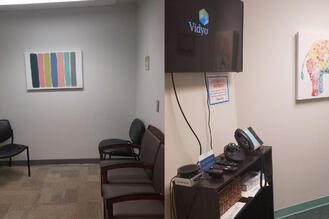 Example Tele Patient Room, Courtesy of Lighthouse Telehealth
Example Tele Patient Room, Courtesy of Lighthouse Telehealth By Alyssa Plotts, UT:10 News Reporter
TOLEDO, Ohio - The COVID-19 pandemic has brought drastic challenges to medical and psychiatric care. The answer for many providers has been telehealth visits with patients. The locally-based nonprofit Harbor has increased its telemedicine services by 500% since the beginning of the pandemic, according to Lighthouse Telehealth.
According to a study conducted by the Commonwealth fund, in-person medical visits plummeted to 60 percent below average during May and June. Provider visits are still 10 percent below the normal average.
Sandy Hall, president of Lighthouse Telehealth said to treat patients safely and provide the best care under COVID restrictions, Harbor has ramped up their telehealth consults with the help of their subsidiary Lighthouse Telehealth. Telehealth appointments were offered by Harbor before the pandemic, so the nonprofit was familiar with the process.
The COVID-19 pandemic has led to an expansion of these visits.
“Patients would visit Tele Patient Rooms where they were examined by a medical aid before meeting with providers on a video call,” Hall said.These rooms contained computers and cameras for patients to speak with their provider, who may have been at a different office location or in another state.
Hall adds this provided a private setting to utilize telehealth for those who may not feel comfortable talking to a provider in their own home. Harbor was also offered a federal grant of over $300,000 this year to expand its telehealth program.
For those who utilize the telehealth program from home, technology has made the process even easier for medical staff and patients. Depending on the patient’s insurance coverage, phone or video call appointments can be offered.
This allows the clinician to visibly see any physical signs that there may be something wrong with the patient. They can then decide if emergency help needs to be contacted for the patient. Telehealth visits have also cut down the wait time for patients seeking care because providers can meet with many patients online or on the phone.
Telemedicine does come with challenges, including issues with patient internet or phone connections, as well as patients not being comfortable speaking about their concerns in their home around family or their spouses. According to Hall, insurance coverage can also become an issue.
Some companies have restrictions on telehealth coverage such as:
Despite these challenges that arise, Harbor and Lighthouse Telehealth plan to utilize telehealth visits even after the COVID-19 pandemic. “The successful transition to these visits has encouraged the expansion of these programs," Hall said.
TOLEDO, Ohio - The COVID-19 pandemic has brought drastic challenges to medical and psychiatric care. The answer for many providers has been telehealth visits with patients. The locally-based nonprofit Harbor has increased its telemedicine services by 500% since the beginning of the pandemic, according to Lighthouse Telehealth.
According to a study conducted by the Commonwealth fund, in-person medical visits plummeted to 60 percent below average during May and June. Provider visits are still 10 percent below the normal average.
Sandy Hall, president of Lighthouse Telehealth said to treat patients safely and provide the best care under COVID restrictions, Harbor has ramped up their telehealth consults with the help of their subsidiary Lighthouse Telehealth. Telehealth appointments were offered by Harbor before the pandemic, so the nonprofit was familiar with the process.
The COVID-19 pandemic has led to an expansion of these visits.
“Patients would visit Tele Patient Rooms where they were examined by a medical aid before meeting with providers on a video call,” Hall said.These rooms contained computers and cameras for patients to speak with their provider, who may have been at a different office location or in another state.
Hall adds this provided a private setting to utilize telehealth for those who may not feel comfortable talking to a provider in their own home. Harbor was also offered a federal grant of over $300,000 this year to expand its telehealth program.
For those who utilize the telehealth program from home, technology has made the process even easier for medical staff and patients. Depending on the patient’s insurance coverage, phone or video call appointments can be offered.
This allows the clinician to visibly see any physical signs that there may be something wrong with the patient. They can then decide if emergency help needs to be contacted for the patient. Telehealth visits have also cut down the wait time for patients seeking care because providers can meet with many patients online or on the phone.
Telemedicine does come with challenges, including issues with patient internet or phone connections, as well as patients not being comfortable speaking about their concerns in their home around family or their spouses. According to Hall, insurance coverage can also become an issue.
Some companies have restrictions on telehealth coverage such as:
- Only covering phone calls without videos
- Only covering video or face-to-face appointments
- Covering therapy/psychiatric care via phone or video
- Covering check-ups or follows ups via phone or video
- Supporting emergency referrals via phone or video
Despite these challenges that arise, Harbor and Lighthouse Telehealth plan to utilize telehealth visits even after the COVID-19 pandemic. “The successful transition to these visits has encouraged the expansion of these programs," Hall said.
 RSS Feed
RSS Feed
